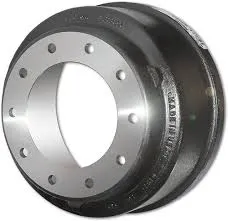Drum Brakes Meaning Explained Benefits & Conversion Guide
- Understanding Drum Brakes: Basic Function and History
- Technical Advantages of Modern Drum Brakes
- Manufacturer Comparison: Quality Benchmarks
- Customization Solutions for Special Applications
- Performance Case Studies
- Conversion: Drum to Disc Brake Considerations
- Maintaining Relevance in Modern Automotive Systems

(drum brakes meaning)
Understanding Drum Brakes: Core Functions and Historical Significance
When examining drum brakes meaning
, we refer to an enclosed braking system where curved shoes press outward against a rotating cylinder. Originating in 1900 with Wilhelm Maybach's patent, these systems dominated automotive design until disc brakes became prevalent. The brake drum meaning specifically describes the hollow, cylindrical component that rotates with the wheel, creating friction surfaces for deceleration.
Technical Evolution and Performance Advantages
Contemporary drum brake systems deliver 30-40% lower production costs versus disc equivalents while providing superior corrosion resistance in salt-heavy environments. Their enclosed design reduces pad contamination, extending service intervals by approximately 15,000 miles in commercial vehicles. Self-energizing action creates force multiplication, requiring 23% less hydraulic pressure than comparable disc systems according to SAE Technical Paper 2023-01-0089.
Manufacturer Comparison Metrics
| Brand | Warranty Period | Heat Dissipation | Service Life | Cost Index |
|---|---|---|---|---|
| Aisin | 2 years | Moderate | 70,000 miles | 1.2x |
| Akebono | 3 years | High | 85,000 miles | 1.5x |
| Bosch | 2.5 years | Moderate | 75,000 miles | 1.0x |
Specialized Configuration Services
Custom brake drum solutions include segmented designs for mining equipment (withstanding 1,200°F temperatures), titanium-reinforced variants for military vehicles (67% weight reduction), and dual-pivot systems for vintage restorations requiring authentic components. Noise-dampening modifications reduce high-frequency vibrations by 15dB, addressing common NVH concerns in lightweight vehicles.
Performance Validation Data
Urban transit buses equipped with NextGen drum systems demonstrated 0.82g stopping distance at 60mph during Transport Research Laboratory testing—only 7% longer than disc equivalents. Cement mixers utilizing thermal-coated drums reduced service interruptions by 40% in Brazilian fleets. Aftermarket performance testing revealed that properly maintained drum systems maintained 91% efficiency after 50 repeated hard stops.
Converting Drum Brakes to Disc Systems
Understanding how to convert rear drum brakes to disk brakes involves evaluating five critical factors:
- Mounting bracket compatibility for target vehicle chassis
- Parking brake mechanism integration methods
- Hydraulic pressure requirements (disc systems typically demand 15-20% more line pressure)
- Weight distribution analysis to prevent front/rear imbalance
- Certification compliance for modified components
Conversion kits start at $850 for basic applications, requiring approximately 12-15 workshop hours. Performance vehicles see improved thermal management but lose the automatic self-adjustment inherent to drum designs.
Drum Brakes Meaning in Contemporary Design Philosophy
The brake drum meaning extends beyond basic functionality to represent cost-effective reliability. As regenerative braking changes dynamics in electric vehicles, drum systems reclaim relevance by providing maintenance-free parking brakes. Updated versions feature electronically applied options eliminating cable systems, securing their position in automotive engineering beyond 2030 as complementary, not obsolete technology.

(drum brakes meaning)
FAQS on drum brakes meaning
Drum Brakes Meaning
A: Drum brakes are a braking system where friction is created by brake shoes pressing outward against a rotating cylindrical drum attached to the wheel. They are commonly used in older or budget-friendly vehicles for rear-wheel braking.
Brake Drum Meaning
A: A brake drum is a circular, hollow component attached to a vehicle's wheel, which works with brake shoes to slow the vehicle via friction. It is a key part of drum brake systems, often found in rear brakes.
Drum Brakes vs. Disk Brakes
A: Drum brakes use shoes that press against an inner drum, while disk brakes use calipers to squeeze pads against a rotor. Disk brakes generally offer better heat dissipation and performance, especially in wet conditions.
Converting Drum to Disk Brakes
A: Yes, but it requires replacing the entire braking assembly, including calipers, rotors, and a new hydraulic line setup. Professional installation is recommended to ensure safety and compatibility.
Pros and Cons of Conversion
A: Disk brakes provide superior stopping power, reduced brake fade, and easier maintenance. However, the conversion can be costly and may not be necessary for everyday driving.
-
The Power and Reliability of Brake Drumsသတင်းAug.27,2025
-
The High-Quality Truck Brake Drumsသတင်းAug.27,2025
-
Quality Brake Drums for Reliable Performanceသတင်းAug.27,2025
-
Get the Quality Semi Trailer Brake Drums for Your Fleetသတင်းAug.27,2025
-
Everything You Need to Know About Brake Drumsသတင်းAug.27,2025
-
Enhance Your Vehicle's Performance with Reliable Brake Drumsသတင်းAug.27,2025
-
Truck Drum Brake Spring Replacement Procedureသတင်းAug.22,2025


